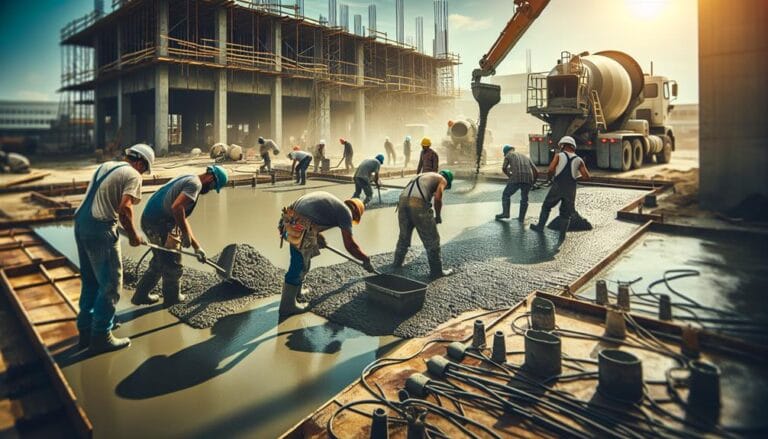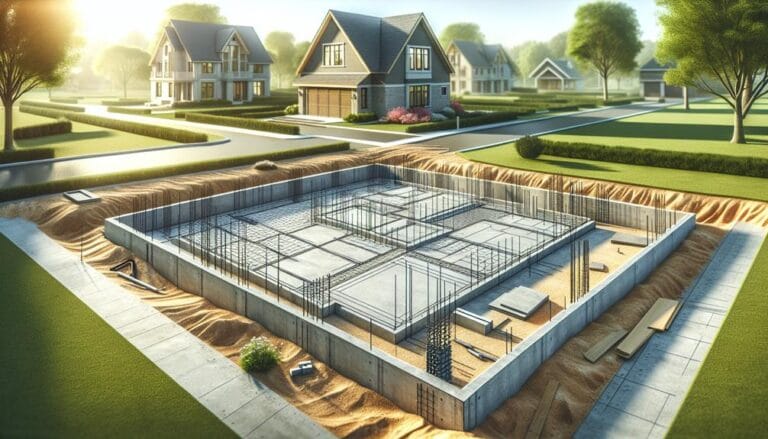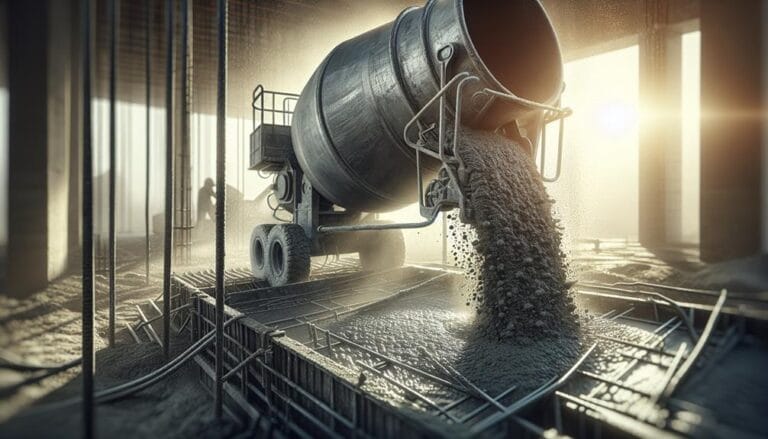Top 10 Tips for Installing Commercial Slabs in Ann Arbor
When installing commercial slabs in Ann Arbor, we emphasize that proper site preparation is key. Conduct a thorough site survey to identify structural issues, evaluate terrain and drainage, and analyze soil conditions. Guarantee subgrade preparation includes effective compaction, drainage management, and soil stabilization. Select the right concrete mix, plan for adequate slab thickness, and strategically place joints. Implement reinforcement strategies and consider weather and climate impacts. Finally, guarantee quality control measures are in place. By following these steps, we can guarantee a durable and successful project. Now, let's dive deeper into these critical elements.
Key Takeaways
- Ensure thorough site preparation, including soil analysis and drainage assessment, to prevent structural issues.
- Select appropriate concrete mix and reinforcement strategies to withstand loads and environmental conditions.
- Adhere to proper slab thickness and joint spacing requirements to ensure durability and prevent cracking.
- Account for extreme weather conditions, such as freeze-thaw cycles and heavy rainfall, in the design.
Site Preparation Essentials
Before we start laying down our commercial slab, we need to guarantee the site is properly prepared to handle the load. This is where site preparation essentials come into play. A thorough site survey is vital, as it helps us identify any potential issues that might affect the structural integrity of the slab or the surrounding environment. This includes evaluating the terrain, identifying any underground utilities, and evaluating the overall drainage of the site. Additionally, a soil analysis is fundamental to determine the soil type, density, and moisture levels, which will inform the design and construction of the slab.
With a thorough understanding of the site's conditions, we can plan and execute a robust foundation that can support the weight of the slab and any structures it will hold. By doing so, we create a solid base that minimizes the risk of structural problems or safety hazards during and after construction.
Proper Concrete Mix Selection
It's time to select the appropriate concrete mix to guarantee our slab can withstand the expected loads and environmental conditions. A quality mix design guarantees that our commercial slab can handle the stresses and strains it will face. For this, we need the right combination of cement, water, and aggregates.
When choosing the mix, we should consider factors like freeze-thaw cycles, traffic load, and exposure to deicing chemicals. The American Concrete Institute (ACI) provides guidelines for creating these mixes, accounting for local conditions and the intended use of the slab. Mix design options include using water-reducing admixtures to minimize the impact of freeze-thaw cycles, increasing the psi rating without affecting workability, and selecting aggregates that are durable and resistant to degradation.
Aggregate selection is vital, as it must be able to handle the weight and traffic the slab will carry. For high-traffic areas, we recommend using a durable mixture reinforced with additional materials. Whether it's for a sidewalk, parking lot, or loading dock, we can customize the concrete mix to suit the unique demands of our project, guaranteeing a long-lasting and robust finish.
Slab Thickness Requirements
Install …
Joint Spacing and Detailing
Now that we've established the necessary slab thickness requirements, let's turn our attention to the vital aspects of joint spacing and detailing. Proper joint placement is essential for a durable and long-lasting commercial slab, particularly when taking into account various environmental factors and traffic loads. There are multiple joint placement techniques to choose from, including saw-cut joints and preformed joints. These techniques guarantee that the slab can handle expansion and contraction without cracking or other defects.
Another important aspect to reflect on is the type and location of expansion joints. Expansion joints allow for the natural expansion and contraction of concrete due to temperature fluctuations and other environmental factors. We must carefully plan and detail the expansion joints to make certain they are positioned at the right places and spacings. This may involve using specialized materials and techniques, such as waterstops and membrane installation, to ensure the joints remain watertight. By paying close attention to these details, we can guarantee that our commercial slab installations in Ann Arbor are of the highest quality and stand the test of time.
Reinforcement Strategies
When specifying reinforcement for commercial slabs, we must balance the need to minimize cracking and distortion with the added complexities and costs associated with increased levels of reinforcement. This balance becomes particularly important when considering different reinforcement strategies.
For instance, we often decide between steel reinforcement, which provides high strength but is more expensive, and fiber reinforcement, which is more cost-effective but lacks the same strength. Proper mesh placement is also key, making certain load distribution is even and minimizing the potential for cracking. However, we must also consider the required reinforcement spacing, taking into account tension requirements and structural integrity.
Additionally, seismic considerations and shear strength play significant roles in our reinforcement strategies. For example, in regions prone to earthquakes, we might opt for more extensive reinforcement to guarantee the slab can withstand the added stress. By carefully considering these factors, we can strike the right balance and guarantee our commercial slabs are both durable and cost-effective.
Weather and Climate Considerations
As we design commercial slabs, extreme weather conditions like hurricanes and tornadoes require us to integrate additional considerations into our reinforcement strategies to guarantee the structures remain resilient against these forces.
Weather and climate considerations highly impact the long-term performance and durability of commercial slabs. Temperature fluctuations, seasonal impacts, and regional climate zones demand special attention. For instance, in Ann Arbor, we experience cold winters and warm summers, resulting in significant temperature variations that affect the slab's expansion and contraction. This fluctuations can lead to cracking and damage if not addressed.
Here is a summary of the key weather and climate considerations in the context of Ann Arbor:
| Weather Conditions | Impacts on Slab | Mitigation Strategies |
|---|---|---|
| Heavy Snowfall | Frost Heave, Water Accumulation | Proper Drainage, Reinforced Slab Edges |
| High Temperatures | Thermal Expansion, Cracking | Reinforced Expansion Joints, Insulation |
| Freeze-Thaw Cycles | Water Infiltration, Cracking | Water-Repelling Coatings, Sealing Joints |
| Strong Winds | Structural Integrity, Cracking | Reinforced Anchorage, Wind-Resistant Materials |
| Rainfall and Flooding | Water Infiltration, Erosion | Water-Repelling Coatings, Proper Drainage |
Drainage Management Systems
To guarantee that commercial slabs can effectively handle weather-related challenges, we need to incorporate thorough drainage management systems that can mitigate the impacts of heavy rainfall and flooding. These systems are essential in ensuring the structural integrity and longevity of the slab. A well-designed drainage system not only prevents water accumulation but also reduces the risk of water seepage and erosion.
There are various drainage system types that can be implemented, depending on the specific requirements and site conditions. Some common types include:
- Stormwater Management: Systems designed to manage and redirect stormwater runoff, reducing the burden on municipal drainage systems.
- Permeable Pavers: Allowing rainwater to percolate through the surface, reducing the volume of stormwater runoff.
- Retaining Walls: Used to control drainage by redirecting water flow and preventing erosion.
Subgrade Preparation Methods
Subgrade Preparation Methods
In preparing subgrades for commercial slabs, we will explore several essential methods to guarantee that water moves away from the slab and doesn't compromise its integrity. The success of the slab depends heavily on the foundation laid beneath it.
To verify proper drainage and prevent water accumulation, it's crucial to evaluate the site and soil conditions accurately. This involves understanding the soil's load-bearing capacity, moisture content, and drainage characteristics. Compaction requirements are critical to achieving a stable subgrade, which can be achieved using various techniques such as mechanical compactors or vibrating plates. Soil stabilization methods like chemical additives or geogrids can also enhance the subgrade's strength.
| Method | Description | Effectiveness |
|---|---|---|
| Grading | Verify uniform subgrade elevation | High |
| Compaction | Prevent settlement and verify stability | High |
| Soil Stabilization | Add strength to weak subgrades | Medium |
| Drainage Systems | Redirect water away from subgrade | High |
Finishing and Curing Techniques
We begin the finishing and curing process for commercial slabs by applying specialized techniques to guarantee strong and durable slab surfaces. Effective finishing and curing methods are essential to achieving a high-quality, long-lasting finish. In our projects, we employ advanced trowel techniques to secure uniform surface texture and stability. These techniques also help in maintaining the ideal moisture content, which enhances the final product's performance.
- Proper Troweling: Using the correct trowel angle and pressure to dispel air pockets and achieve a smooth finish.
- Surface Treatments: Applying specialized treatments to enhance surface hardness, resistance to wear, and water repellency.
- Moisture Control: Maintaining the ideal moisture level to prevent cracking and secure a consistent finish.
Quality Control Measures
Throughout the construction process, we employ rigorous quality control measures to confirm that the commercial slabs meet the highest standards of performance and longevity. Our quality assurance program guarantees that every phase of the installation process, from preparation to finishing, adheres to strict standards. We realize that even minor discrepancies can greatly impact the overall quality and durability of the slabs.
To maintain consistency and excellence, we implement meticulous inspection protocols. Our team of experts conducts regular inspections during each stage of the installation process, confirming that the slabs meet our high standards. These inspections involve thorough examinations of the slab's surface, density, and structural integrity. We also verify that the materials used meet the specifications outlined in the project plan.
Our quality control measures are designed to identify and address any issues promptly, confirming that the end-product exceeds our clients' expectations. By following these rigorous standards, we can confidently guarantee that our commercial slabs will withstand the demands of high-traffic environments and provide long-lasting performance.
Frequently Asked Questions
Can I Pour Concrete Directly Onto Dirt Without Issues?
"We prefer to err on the side of caution, recommending a layer of gravel for proper drainage. Pouring directly onto dirt might 'get away' with it, but we wouldn't risk long-term slab stability."
How Do I Handle Moisture When Using a Vapor Retarder?
When using a vapor retarder, we make certain to follow proper installation techniques and guarantee adequate coverage to prevent moisture from seeping through, thereby maintaining the integrity of the slab.
Are Curing Compounds or Moisture Mitigation Systems Compatible With Adhesives?
When using a vapor retarder, we find that curing compounds and moisture mitigation systems can sometimes be compatible with adhesives, but we need to guarantee clear specifications and adherence to manufacturer guidelines to avoid any potential issues.
Can I Ensure Subfloor Flatness for Adhesives to Bond Properly?
To guarantee subfloor flatness for adhesives to bond properly, we perform thorough subfloor preparation, which includes mechanically removing curing compounds and applying the right adhesive selection, guaranteeing a strong and long-lasting bond.
How Often Should I Test for Moisture in a Concrete Subfloor?
'We test for moisture in a concrete subfloor regularly, especially during subfloor preparation. This guarantees the slab is dry and stable, allowing for effective adhesive bonding and reducing the likelihood of flooring failures.'







